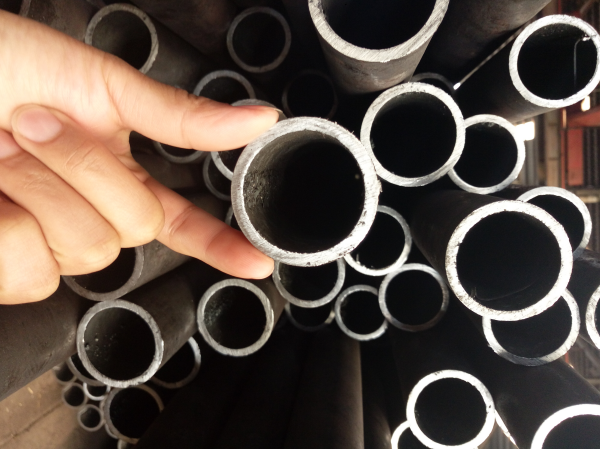
Seamless steel pipe & tube, as an indispensable material in the modern industrial field, its quality and performance have a vital impact on the safety and stability of various engineering projects. However, in the production and use of seamless tubes, various defects often occur, which not only affect the performance of the steel pipe, but also may threaten the safety of the engineering project. Therefore, understanding the defect characteristics and causes of seamless tubes is of great significance to improving the quality and use effect of seamless steel pipes.
Common outer surface defects of seamless tubes (smls tube):

Microscopic characteristics: The scratches on the inner wall of the cross-section of the seamless steel tube are in the shape of a groove with a depth of 1 to 2 cm. Oxidative decarburization does not appear at the edge of the groove. The surrounding tissue of the groove has the characteristics of metal rheology and deformation extrusion. There will be microcracks due to sizing extrusion during the sizing process.
Seamless steel pipe, as an indispensable material in the modern industrial field, its quality and performance have a vital impact on the safety and stability of various engineering projects. However, in the production and use of seamless steel pipes, various defects often occur, which not only affect the performance of the steel pipe, but also may threaten the safety of the engineering project. Therefore, understanding the defect characteristics and causes of seamless steel pipes is of great significance to improving the quality and use effect of seamless steel pipes.
Ultrasonic detection technology for seamless steel tubes:
Ultrasonic detection refers to the detection of seamless steel tubes using the principle of electromagnetic induction. When using the ultrasonic detection method for detection, it is first necessary to excite a beam of ultrasonic waves inside the seamless steel tube, which will propagate inside the pipe of the seamless steel tube. If the ultrasonic wave is reflected, it indicates that there are defects on the surface of the seamless steel tube. During the detection process, the ultrasonic wave will produce a series of changes inside the pipe of the seamless steel tube. The quantitative information of the defects of the seamless steel tube can be fully displayed by processing this information with a flaw detector. This detection method can detect multiple steel pipe defects at the same time with high sensitivity. It should be noted that this detection method is not suitable for fast production lines due to its slow detection speed. Therefore, this detection method is mostly used when inspecting high-quality seamless steel tubes in detail.
Causes of seamless tube defects:
1. Raw materials
The poor internal structure and poor surface quality of raw materials are important causes of seamless steel tube defects. Poor internal structure may cause defects such as internal folding, internal cracks in the pipe wall, and delamination; poor surface quality may cause defects such as external folding.
2. Process operation
Improper process operation such as improper heating, excessive deformation pressure, and incomplete cleaning of the pipe surface are also important causes of seamless steel pipe defects. Improper heating may cause defects such as internal folding, external folding, and internal cracks in the pipe wall; excessive deformation pressure may cause defects such as cracks.
3. Equipment
Poor equipment performance, looseness, scratches, etc. may also cause seamless steel tube defects. For example, damage to the piercing machine roll or the tube rolling mill roll may cause defects such as rolling folding.
4. Problems during transportation
Seamless tubes may be subject to adverse effects such as impact or extrusion during transportation, which may cause defects of varying degrees on the surface or inside of the pipe.
Prevention and control of seamless tube defects:
In order to reduce the occurrence of seamless steel tube defects and improve the quality and use effect of seamless steel tubes, the following measures need to be taken:
1. Strengthen raw material quality control
Strictly control the internal organization and surface quality of raw materials, and select high-quality raw materials for production.
2. Optimize process operation
Reasonably set process parameters such as heating temperature and deformation pressure to ensure the stability and accuracy of process operation. At the same time, strengthen the surface cleaning of the tube blank to ensure the smoothness and flatness of the tube blank surface.
3. Strengthen equipment maintenance and management
Regularly inspect and maintain production equipment to ensure the normal operation and stable performance of the equipment. Damaged equipment parts should be replaced and repaired in time to avoid equipment failures affecting the quality of seamless steel pipes.
4. Strengthen quality inspection and monitoring
Establish a complete quality inspection and monitoring system to monitor and inspect the production process of seamless steel pipes throughout the process. The defects found should be handled and rectified in time to ensure that the quality of seamless steel pipes meets the standard requirements.
Conclusion:
The defect characteristics and causes of seamless steel tubes are multifaceted, and comprehensive analysis and control are required from the aspects of raw materials, process operation, equipment, transportation, etc. By strengthening raw material quality control, optimizing process operation, strengthening equipment maintenance and management, and strengthening quality inspection and monitoring, the generation of seamless steel tube defects can be effectively reduced, and the quality and use effect of seamless steel tubes can be improved.
Go here to learn more about " Cross-rolling Piercing Process and Quality Defects and their Prevention "
